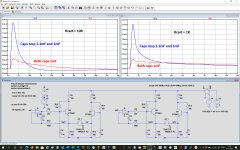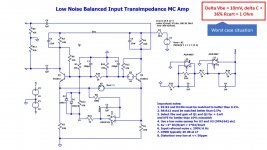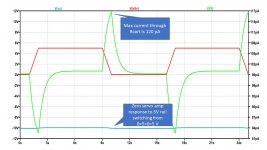Remember the gain is [inversely] proportional to the resistance of the cart. ...
Bonsai,
In the meantime some info's that might be helpful to show that switch on has to be taken care off.
Two sims below showing what current flows through the Cart at switch on for resp. a 10R and a 1R cart.,
Slight 10% tolerances between the two 1mF caps already shows a high sensitivity.
These sims were done with two exactly equal ZTX851's, which make the results even more optimistic.
So work in progress, but I have all the faith in a good solution.
Hans
.
In the meantime some info's that might be helpful to show that switch on has to be taken care off.
Two sims below showing what current flows through the Cart at switch on for resp. a 10R and a 1R cart.,
Slight 10% tolerances between the two 1mF caps already shows a high sensitivity.
These sims were done with two exactly equal ZTX851's, which make the results even more optimistic.
So work in progress, but I have all the faith in a good solution.
Hans
.
Attachments
That looks very encouraging. I’m wondering if a resistor from the base to 0V on each transistor also won’t help to better define the tranny operating conditions once the circuit has stabilized.
I think a good cart start up current objective is about the same as the peak signal current - so a common figure would be 30-40 uA. .
I think a good cart start up current objective is about the same as the peak signal current - so a common figure would be 30-40 uA. .
A transistor shorting both bases to gnd is an idea, but the circuit is highly dependent on hfe and hfe differences, to be solved first of all IMO.
Hans
Hans
This is super interesting stuff.
A somewhat more general question that I‘m trying to figure out: why isn’t a balanced topology the default for phono, especially MC. With the cartridge and cables being prone to induced hum (especially when there is tube equipment with big transformers nearby), the CMR of a balanced topology seems preferable.
In addition to slightly more complex circuits, are there any other general downsides to balanced topologies?
A somewhat more general question that I‘m trying to figure out: why isn’t a balanced topology the default for phono, especially MC. With the cartridge and cables being prone to induced hum (especially when there is tube equipment with big transformers nearby), the CMR of a balanced topology seems preferable.
In addition to slightly more complex circuits, are there any other general downsides to balanced topologies?
Couple of reasons.
1. The cartridge isn't really balanced as a source
2. Noise penalty in the preamp puts a lot of people off
3. Due to point 1 you can cancel out common mode pickup in the cabling, but any pickup in the cartridge (which is basically an antenna) is differential mode so not cancelled.
Some tests have shown about a 20dB reduction in noise with a balanced input which I still think is worth having even if it's inaudible 🙂
1. The cartridge isn't really balanced as a source
2. Noise penalty in the preamp puts a lot of people off
3. Due to point 1 you can cancel out common mode pickup in the cabling, but any pickup in the cartridge (which is basically an antenna) is differential mode so not cancelled.
Some tests have shown about a 20dB reduction in noise with a balanced input which I still think is worth having even if it's inaudible 🙂
This is super interesting stuff.
A somewhat more general question that I‘m trying to figure out: why isn’t a balanced topology the default for phono, especially MC.
Because 99% of arms are wired unbalanced. Also, you'd be amazed how few people understand what "balanced" really means. It's not about voltages, it's about impedances and currents.
A more reasonable objection to balanced working for vinyl is that unless you do it with a (properly balanced) transformer you suffer a 3dB degradation in random noise. Nevertheless, a moving coil cartridge is as balanced a transducer as you're ever going to get and the cable and arm do pick up interference.
Incidentally, the nV/root Hz numbers people are bandying about for this circuit seem rather high. If it's a moving coil cartridge you'd like <1nV/root Hz.
This amp has an input noise voltage density of ~0.3 nV/root Hz - so well below 1nV/root Hz ! (see e.g. post #1 and #14)
The numbers you may refer to mentioned in some of the posts are output noise voltage densities
The numbers you may refer to mentioned in some of the posts are output noise voltage densities
Because 99% of arms are wired unbalanced. .
Balanced by definition means same impedance on each leg. Arm wiring will meet that definition. Or do you mean the coax from the arm to the preamp? I can't comment if the 99% is true for that but 100% of my turntables are STP.
Couple of reasons.
1. The cartridge isn't really balanced as a source
2. Noise penalty in the preamp puts a lot of people off
3. Due to point 1 you can cancel out common mode pickup in the cabling, but any pickup in the cartridge (which is basically an antenna) is differential mode so not cancelled.
Some tests have shown about a 20dB reduction in noise with a balanced input which I still think is worth having even if it's inaudible 🙂
Thank you for setting my head straight. Point #3 is what I overlooked when I was thinking about this. If there's interference that can be picked up at some point before the pre's input the coil in the cardridge is probably much more prone to it then the cables. And as you point out, that wouldn't be a common-mode signal. (Otherwise, people wouldn't be putting humbucker pickups on electric guitars)
Note that most MM/MI are wired humbucking. The big exception is Grado, which is why they are low inductance for the breed, but many complain about hum issues with them.
Note that most MM/MI are wired humbucking. The big exception is Grado, which is why they are low inductance for the breed, but many complain about hum issues with them.
I can confirm that. I have a Grado Sonata 3 high-output MI and it does pick up more hum then an AT95. It is comparable though to an Ortofon OM system. Could this be due to the fact that the Audio-Technica is a "dual moving magnet" system? (I have had a few different styli for the AT and OM systems but obviously these don't influence hum pickup)
(The Grado sounds lovely BTW. the differences in hum can be measured and made audible with extreme gain settings but for my practical listeneing purposes they are not a problem at all)
Last edited:
May I humbly add that when a cart is picking up interference, it will lead in both cases, Balanced as well as SE, to the same (differential) signal entering the preamp.
So here is no winner IMO.
Hans
So here is no winner IMO.
Hans
Last edited:
@Zack. Coil orientation is different between AT and Ortofon so that could be the reason.
@Hans: agree, for me personally the cost/performance trade off is worth it, but it's an emotional choice as much as an engineering one.
@Hans: agree, for me personally the cost/performance trade off is worth it, but it's an emotional choice as much as an engineering one.
@Zack. Coil orientation is different between AT and Ortofon so that could be the reason.
That's good to know... should make for a few interesting experiments over the weekend...
As I said, the hum pick-up isn't really a practical problem for me, but it was always something that I thought I wanted to optimize a little more simply from an engineering perspective and I had thought that a balanced-input phono stage could help with that.
While a balanced input has its benefits it wouldn't help with that particular endevavor so thanks again for all those explainations.
This is not the thread, but I do have some experiments that children have put on hold on MM grounding to see if that changes anything. Some day I will do them.
Balanced by definition means same impedance on each leg. Arm wiring will meet that definition. Or do you mean the coax from the arm to the preamp?
As you say, the wiring within the arm is balanced. I was thinking mainly of the (much longer) lead from the arm base. By the way, I've been treating cartridges as balanced for decades. Provided you're not unfortunate enough to have decided that you like a cartridge that picks up hum, balanced wiring is useful.
Last edited:
Its not possible to stop series mode hum pick up where an interfering mag field cuts just one of the connections to the cart. If is cuts both (more typical I'd say), you will get some reduction in CM noise - as Bill says, 20 dB is not to be sniffed at.
With current input MC amplifiers like this one (and the X-Altra MC/MM), the Zin is very low at just a few Ohms, so capacitive hum noise coupling is normally not an issue, and I'd venture even with voltage mode MC amps, the same applies since the Rin is usually not more than 100-200 Ohms.
Most arm wiring is bundled, so the area for mag pick-up is limited and from the T/T to the amplifier its shielded which also helps.
The thermal noise on this balanced pre will not beat the X-Altra MC/MM (I measured 232pV/rt Hz on one of the builds) but it may offer some rejection of externally picked up CM noise that an unbalanced input will let slip through.
YMMV
🙂
With current input MC amplifiers like this one (and the X-Altra MC/MM), the Zin is very low at just a few Ohms, so capacitive hum noise coupling is normally not an issue, and I'd venture even with voltage mode MC amps, the same applies since the Rin is usually not more than 100-200 Ohms.
Most arm wiring is bundled, so the area for mag pick-up is limited and from the T/T to the amplifier its shielded which also helps.
The thermal noise on this balanced pre will not beat the X-Altra MC/MM (I measured 232pV/rt Hz on one of the builds) but it may offer some rejection of externally picked up CM noise that an unbalanced input will let slip through.
YMMV
🙂
Some more work today on the balanced transimpedance head amp.
I found a way to minimize the effect of the separate base decoupling caps. Basically they don't need to be completely separate. The two bases are now coupled by a 1k resistor which helps to deal with gross differences in capacitance that was one of the problems on the original concept that lead to high currents through the cartridge.
This has allowed the servo amp to be easily configured so that it takes care of start up currents and servos out any differences in the transistor Vbe's. If this becomes a practical design, ideally you would need to select for delta Vbe = 1mV or less and hFE to within 10% (see mediatechnology's post in this regard in Jurgen's mpp thread - it seems quite easy to do). However the sim was done with a delta Vbe of 10 mV and high cartridge current is easily servo'd out. See the next post.
I found a way to minimize the effect of the separate base decoupling caps. Basically they don't need to be completely separate. The two bases are now coupled by a 1k resistor which helps to deal with gross differences in capacitance that was one of the problems on the original concept that lead to high currents through the cartridge.
This has allowed the servo amp to be easily configured so that it takes care of start up currents and servos out any differences in the transistor Vbe's. If this becomes a practical design, ideally you would need to select for delta Vbe = 1mV or less and hFE to within 10% (see mediatechnology's post in this regard in Jurgen's mpp thread - it seems quite easy to do). However the sim was done with a delta Vbe of 10 mV and high cartridge current is easily servo'd out. See the next post.
Attachments
Last edited:
Here are the cartridge currents with the +5V supply (V5v) switched on and off - it is negligible at ~120 pA. I used rise/fall times of 1 second for the +5V supply since in a practical design the +5V would simply be derived from the main +18V supply through a divider and heavily filtered at the output. (I used 47 Ohms and 1000uF on the X-Altra MC/MM with an LM4562 and got 7nV integrated noise 20-20kHz)
Attachments
Last edited:
- Home
- Source & Line
- Analogue Source
- Low noise Balanced MC Pre


